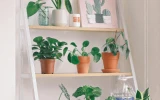6 Indoor Plants That Help Create A Healthier Home
Published on Aug 10, 2021

Did you know that Australians spend around 90% of their time at home?
And while there is much known about outdoor air pollution, polluted indoor air can also pose health risks.
Indoor plants not only look great, but some species are also natural air filters that could actually improve the health of your home – these are our top 6.
The Indoor Plants Rating System
Many natural plant varieties successfully remove toxins such as formaldehyde and carbon monoxide to create a healthier home.
To make buying healthy plants for your home a little less daunting, we’ve put together the ultimate plant guide below.
It includes information on:
1. Toughness
This is how much maintenance is needed to keep your plant thriving.
2. Health benefits
These are the different special abilities of each plant, such as repelling insects or removing toxins from the air.
3. Pricing
We’ve rated the affordability factor of the top 6.
6 Best Plants for Purifying Indoor Air
1. Zanzibar Gem (Zamioculcas zamiifolia)
This one is known by experts as almost impossible to kill. Plant it in a low light area and mist its leaves regularly but make sure you don’t water the soil too much.
The Zanzibar always looks amazing with its tropical leaves and are a fantastic addition to any home.

Toughness
Standard potting mix will suffice here, kept out of direct sunlight and only water once a month.
Health Benefits
This plant is resistant to pests and diseases, while its air purifying qualities remove many toxins from your indoor air.
Pricing
Prices range on these. They usually start from around $20 for a 25cm plant (size of pot not included in measurement) to $100-$120 for a 70cm plant
These plants can be toxic, so keep away from kids and pets, and wash your hands after handling.
2. Spider Plants
The long, cascading leaves of this popular plant makes them an aesthetically striking choice for your home.
These plants thrive in warm temperatures and are easy enough to grow. Look out for the small flowers first that will develop into the signature spider-like fronds.

Toughness
This is a great place to start for a novice gardener. They prefer bright, indirect light and need water weekly. Ensure you don’t saturate the plant and keep it in a cooler part of the house.
Little tip: Using distilled water or rainwater stops the leaves from turning brown.
Health Benefits
The spider plant does a fantastic job of absorbing mould and allergens, while targeting indoor air toxins such as formaldehyde and xylene.
Pricing
A really affordable option at between $5-$10.
3. Aloe Vera
Everybody knows the power of Aloe Vera – these plants need minimal care, look great in most rooms of the house and have many benefits.

Toughness
Water deep into the roots every few weeks during warm months; less so during winter. This plant will do well in moderate temperatures and should be placed in indirect natural or artificial light.
Health Benefits
You can treat cuts and burns thanks to its anti-inflammatory properties as well as eliminate carbon monoxide, benzene, formaldehyde, trichloroethylene, xylene and more. It’s completely non-toxic as well
Pricing
My latest small Aloe Vera plant at Bunnings cost me $10.50. If it survives, I’d probably spend a bit more to get a larger Aloe plant.
4. Snake Plant
This is a popular choice in people’s bedrooms. Pop it in minimal light to bring a little colour into a bedroom and help you to sleep better. Here’s what you need to know.

Toughness
As one of the hardier indoor plants available, this option will look cared for even if you haven’t touched it for weeks. They’ll survive low light, drought and pest problems.
Health Benefits
Makes your air cleaner and also converts carbon monoxide into oxygen, improving your sleep.
Pricing
A 19cm plant costs $30 from Ikea but you can shop around. Keep in mind that there are many varieties (it’s also known as mother-in-law’s tongue).
5. Swiss Cheese Plant (Monstera deliciosa)
My personal favourite, the Monstera is native to the tropical forests of southern Mexico. Its retro style is making a comeback but keep in mind that it does require a little more care than others.

Toughness
You need to keep it in a warmer temperature, as colder temperatures will slow or stop its growth. Water only when soil is dry to prevent waterlogging. They are prone to pests, so you’ll need to keep an eye on it.
Health Benefits
The Monstera is effective at humidifying air-conditioned rooms. It looks great but it will need plenty of space to grow. Just keep it away from your pets and small children, as the leaves may be poisonous if ingested.
Pricing
A 24cm plant will cost around $50 but you can also pick up mature varieties at fair prices if you shop around sites like Gumtree.
6. Areca Palms
I love the look of these but they are the hardest to care for and most expensive. Try this choice if you really want to test your green thumb.

Toughness
Monitor it closely to ensure that you are getting the water ratio just right. A great tip is to grab a self- watering pot to help get the balance right – a standard pot should cost between $15-$30.
Health Benefits
This is another plant that absorbs air pollutants, namely toluene and acetone.
Pricing
This should cost between $20-$50. Look after this one however, and you’ll have it for about 10 years.
Note: The availability of these plants is seasonal. We recommend getting advice from an expert if you need further care information.




